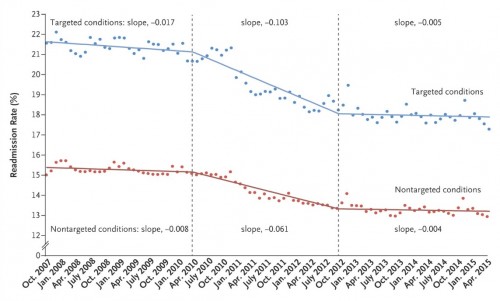Color me surprised. “Readmissions, Observation, and the Hospital Readmissions Reduction Program“:
BACKGROUND: The Hospital Readmissions Reduction Program, which is included in the Affordable Care Act (ACA), applies financial penalties to hospitals that have higher-than-expected readmission rates for targeted conditions. Some policy analysts worry that reductions in readmissions are being achieved by keeping returning patients in observation units instead of formally readmitting them to the hospital. We examined the changes in readmission rates and stays in observation units over time for targeted and nontargeted conditions and assessed whether hospitals that had greater increases in observation-service use had greater reductions in readmissions.
METHODS: We compared monthly, hospital-level rates of readmission and observation-service use within 30 days after hospital discharge among Medicare elderly beneficiaries from October 2007 through May 2015. We used an interrupted time-series model to determine when trends changed and whether changes differed between targeted and nontargeted conditions. We assessed the correlation between changes in readmission rates and use of observation services after adoption of the ACA in March 2010.
Unless you’ve ignored the rantings of many, many posts here at TIE, you know that the government has been trying to reduce readmissions to hospitals as a means to improve quality and decrease spending. This study checked in on that. It appears that it’s happening:
The blue line is the readmission rate for targeted conditions. The ACA was passed in March, 2010 (first dotted line). The program to penalize hospitals began in October 2012 (second dotted line). It sure looks like the hospitals began to get their act in gear once the ACA was law in preparation for this, and achieved a significant lowering by the time the program started. They also seem to have held the line.
They’ve also seen reduced readmissions for nontargeted conditions (red line). Further, it doesn’s appear they’ve achieved these goals by pushing returning patients into observation units to avoid admissions.
This isn’t an RCT, so we can’t prove causality. But the timeline is compelling. We don’t know whether these changes are long-lasting, but they’re still seeming to stick. We also don’t know how this program has affected other measures of quality or care, and that I do care about. We will need to follow that closely in the future.
But it seems like the ACA’s policy has made a difference. I can admit when I’m wrong.


